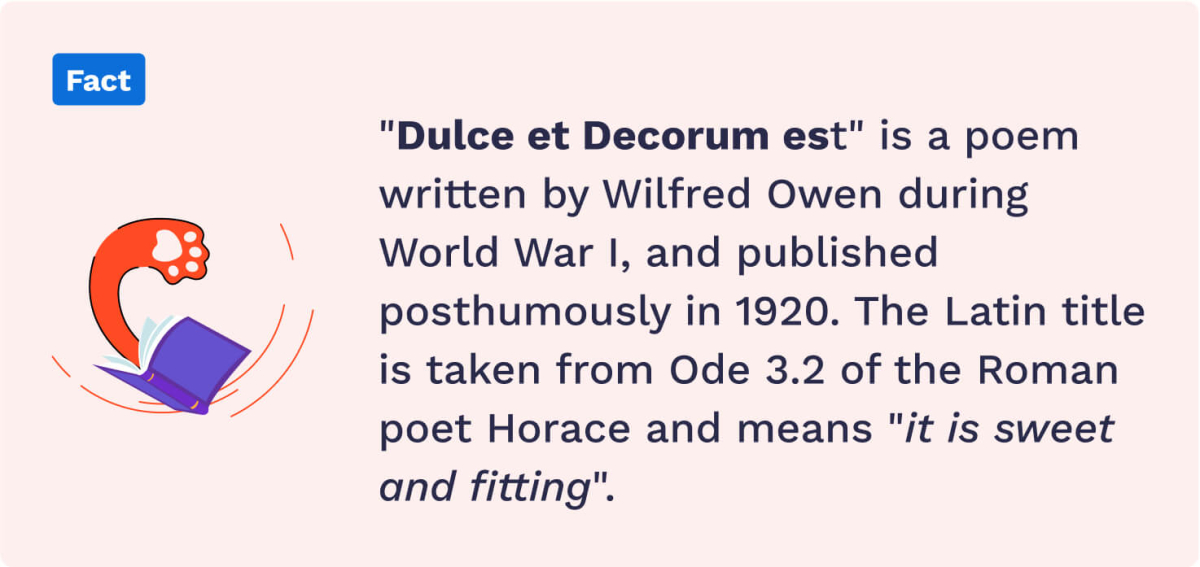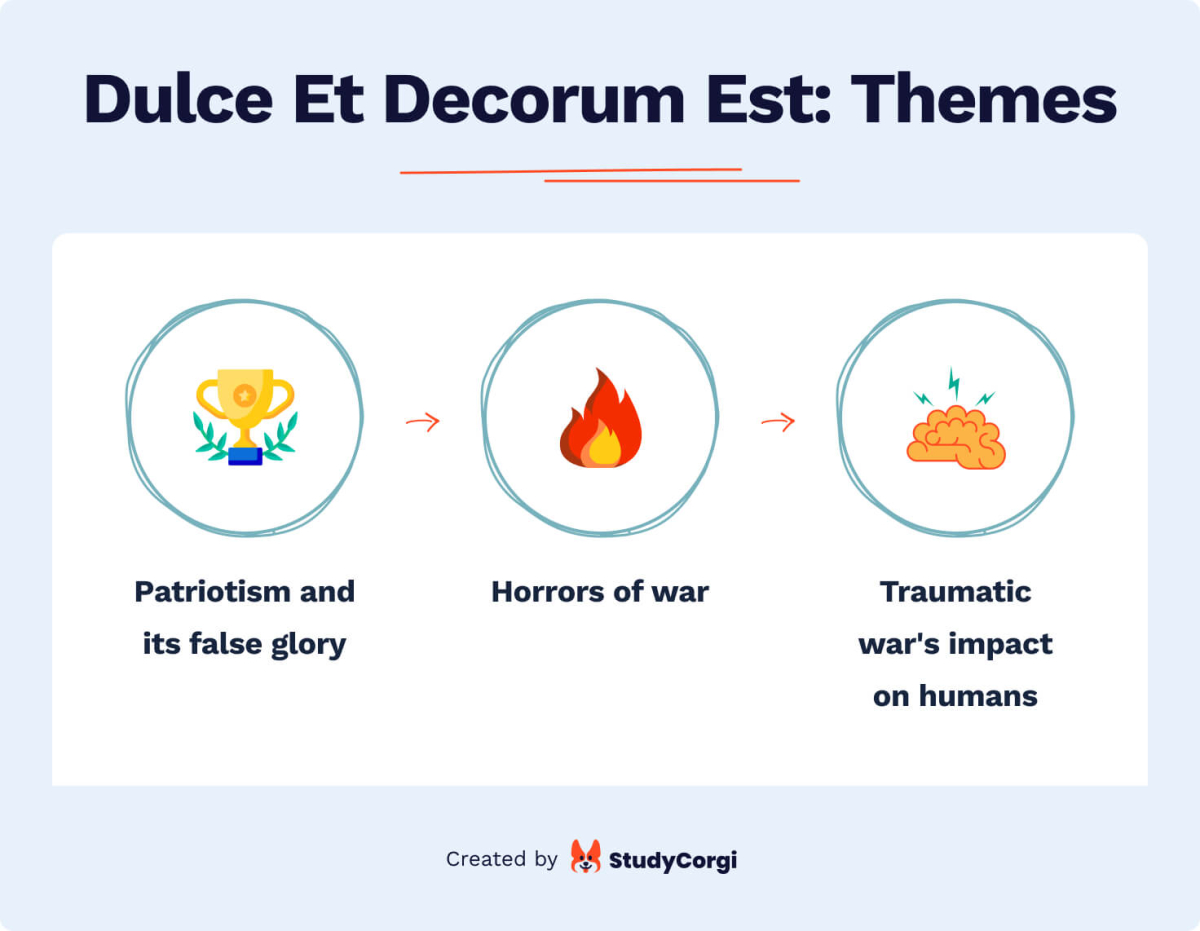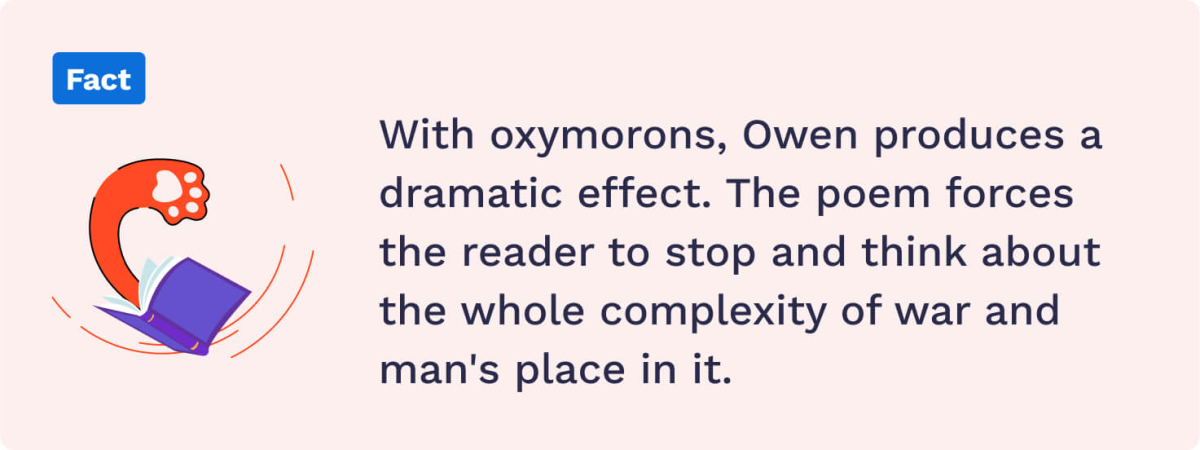“Dulce et Decorum Est” by Wilfred Owen concentrates on the shocking details of events soldiers came through in World War I. Owen recalls the war realities by showing readers the soldiers’ urgency when faced with death.

If you’re stuck with writing a paper on the poem, you’re in the right place! Below, you will find the Dulce et Decorum Est analysis, summary, answers to the most common questions. And don’t forget to check our free essay examples.
Let’s start!
Dulce Et Decorum Est: Summary
The author paints a group of marching soldiers in a muddy landscape. The soldiers are tired and sick. They are coughing like older adults, and their knees are shaking. Besides, they are far from the fighting spirit. Some of them walk like they seem to be sleeping. Some even lost their boots, and their feet are bleeding.
At the same time, they carry heavy packs while going away from light flares, used by the German army to spot an enemy by lighting up the territory. Their destination is a distant camp.
Soldiers are worn out physically and mentally. Their perception is clouded as if they were drunk. They can hardly recognize an impending threat.
Suddenly, one from the group warns about a gas attack so that soldiers can put on their protecting helmets. Everyone manages to do it on time, except for one soldier. The author saw his suffering and agony.
The soldier death reminded Owen of someone caught in fire or lime, used to blind the enemy in ancient times. He compares this terrible scene with drowning in the ocean, not underwater, but in the air full of poisonous gas.
Then, the reader is brought into the author’s post-war reality. Even years later, Owen did not escape the picture of yelling and dying in front of his eyes comrade-in-arms.
After sharing his grievous experience, the author turns to the readers and states a straightforward thing. It lies in the fact that if they took his boots and walked a mile, they would never have said to their children the war is glorious.
The author recalls marching behind a wagon with a dying wrecked-face soldier, who reminds of someone passing away from cancer or other diseases. Such memories dispel an “old lie” that dying for one’s country is sweet and fitting.
Dulce Et Decorum Est: Literary Analysis
We approach the literary analysis of the Dulce Et Decorum Est. You will understand the poem’s themes, the literary devices the author used, and the poem’s language.
Let’s go!

Dulce Et Decorum Est: Theme
The author illustrates the relationship between reality and heroic ideals. He does it via two central themes: patriotism and its false glory and horrors of war.
The poem’s title and final lines, “Dulce et Decorum Est,” are from Horace’s Ode 3.2. The bar is a Latin equivalent for “It is sweet and fitting to die for one’s country.” It echoes powerfully in the hearts of the young, showing only the heroic and romantic side of patriotic death and other sacrifices “for good.”
In reality, it’s far from that. The author argues such a way of war glorification, calling it an “old Lie.” Each horror depicted from the “on-site” shatters the enduring myth that the war is glorious.
Line by line, the poem shows how terrible and horrifying the war experience is. One thing is clear: if the reader could see and feel all the author’s horror, they would not talk so zealously about patriotism and the delights of war.
All the above is bolstered by the third theme: the traumatic war’s impact on humans. In this context, possible terrible emotional or physical pains will not get better with time. The lasting effects of war trauma barely level out all the arrogance and glory of war.
Dulce Et Decorum Est: Literary Devices
Now, we will stop on Dulce Et Decorum Est literary devices. To express the main idea, the author used several poetic techniques, including:
- Imagery
- Metaphor
- Symbolism
- Irony
- Oxymoron
Let’s explore Dulce Et Decorum’s literary devices and look at a few examples of their application.
Imagery
The author successfully uses many similes to make the terror visible. Thanks to them, it is easier for readers to perceive the pain, horrific images, and agony.
One of the examples is in the very beginning: “like old beggars under sacks” — soldiers are shown not as brave mighty heroes, but as the homeless and weak tramps who beg for a living.
Here is the list of other same-purpose phrases: “coughing like hags,” “like a devil’s sick of sin,” “obscene as cancer,” “like a man in fire or lime,” “as under a green sea,” and “bitter as the cud.”
Metaphor
Dulce et Decorum Es is so literal that it has only a single metaphor. It is used in the poem to make vivid imagery of the soldiers’ physical state. The metaphors are the compelling phrases, namely, “drunk with fatigue” and “deaf even to the hoots.”
Symbolism
We have already touched a bit upon the symbolic elements in the poem’s imagery. Symbolism pictures the WWI experience like a nightmare rather than a real-life event.
The first symbolic element author introduces a green sea in which one of the soldiers “dies” after a gas attack, as he could not put on a mask on time. It can be explained by what Owen saw then: a gas fog through the mask glass.
Using this symbol in pair with the verb “drowning” transmits the painful and cruel way the soldier died. Besides, it builds the link between drowning in the ocean and gas suffocation. It is easier for readers to imagine the terrible feeling of lacking enough oxygen underwater.
Irony
The irony shows up in the poem’s very beginning. First, the reader sees the title Dulce et Decorum Est, meaning the poem will show how great it is to fight for the homeland. The first line is opposite to something glorious and sweet.
Reading more into the poem opens up terrifying things about war gradually. The author uses irony to express the violence, making the phrase in the title an illusion.

Oxymoron
Along with irony and other poetic techniques, the author uses oxymorons. Two contradictory words used together make an oxymoron.
In phrase “To children ardent for some desperate glory,” the initially negative “desperate” word is combined with the joyous “glory.” Another oxymoron is “An ecstasy of fumbling,” where the opposing state of extreme happiness combines with an awkward way of doing something.
With oxymorons, Owen produces a dramatic effect. The poem forces the reader to stop and think about the whole complexity of war and man’s place in it.
Dulce Et Decorum Est Language: Meter, Rhythm, Rhyme Scheme, Tone
The language of the poem Dulce Et Decorum Est is composed of several poetic devices, including meter, rhythm, rhyme scheme, and tone. Let’s describe each of them:
- Meter. The poem is composed of five-syllable pairs. Each pair’s first syllable is unstressed, and the second is stressed. The Dulce Et Decorum Est meter pattern is iambic pentameter.
- Rhythm. Combined with other techniques, the poem’s somber rhythm expresses imagery. The words themselves are rumbling. They collide to paint a horrific picture of the field where soldiers march. What is more, it is evocative of the rhythm of the heart.
- Rhyme scheme. Although the poem’s meter is rather complex, the rhyme pattern is simple. The rhyme scheme in Dulce Et Decorum Est is ABABCDCD. The author manages with simple words and no more than double rhyme sounds repetition.
- Tone. The poem’s tone is bitter, angry, and critical. The trauma and self-recrimination heat the speaker’s voice. That’s why he so accurately conveys all the fears and horrors he endured. Along with the angry tone, the ironically used “my friend” addressing those supporting an “old lie” impacts them more intensely.
Now, we move on to the poem’s setting.
Dulce Et Decorum Est: Setting
Owen does not give the exact setting location, but it is clear from the context that the action takes place in 1917 winter in France.
What is this context?
The poem is written during Wilfred Owen’s actual WWI experience. Here when he wrote letters with stories of the dying soldier.
Besides, there are elements in the poem, which serve as a clue to understanding the setting.
The most evident is green chlorine gas, deployed by the German army since 1915, and “clumsy helmets” or gas masks, used as gas attacks responsive measure.
Gas shells and flares are also WWI-specific elements. Soldiers never used them before.
The setting breaks into the past and present in terms of the author. After two stanzas, we shift to his indeterminate present in the past. It shows us that his horrors did not leave him even in the postwar peacetime.
Dulce Et Decorum Est Essay Ideas
Now that you have explored the poem analysis, it’s time to write the Dulce et Decorum Est analysis essay. We gathered 15 essay topic ideas to make things simple. Please, pick any from the list:
- Dulce Et Decorum Est poem figurative language
- Dulce Et Decorum Est poem literary devices
- Irony in poem Dulce Et Decorum Est
- Symbolism in poem Dulce Et Decorum Est
- What is the theme of the poem Dulce Et Decorum Est?
- How does Wilfred Owen describe the horrors of war in the poem Dulce Et Decorum Est?
- The brutality of war in the poem Dulce Et Decorum Est
- How does Wilfred Owen convey the human costs of war in the poem Dulce Et Decorum Est?
- Illustration of First World War in the poem Dulce Et Decorum Est by Wilfred Owen
- Literary devices and themes in Dulce Et Decorum Est
- Dulce Et Decorum Est: is it charming to die for one’s country?
- Why was Dulce Et Decorum Est written: literary and historical context?
- What is the Dulce Et Decorum Est message?
- The portrayal of death in Dulce Et Decorum Est by Wilfred Owen
- Depiction of tragedies of war in the poem Dulce Et Decorum Est
If the topics are not enough and you still have any questions, we suggest you check out an example of a ready-made Dulce et Decorum Est and The Things they Carried: Compare & Contrast Essay.
To help you finally delve into the topic, we gathered the most frequently asked questions and comprehensive answers to them below.
Tune in!
Dulce Et Decorum Est: Questions and Answers
Below you will find comprehensive Dulce et Decorum Est questions and answers.
Who Wrote Dulce Et Decorum Est?
Dulce et Decorum Est was written by Wilfred Edward Salter Owen, an English soldier, and poet. He was born on 18 March 1893 near Oswestry in Shropshire. Among the First World War poets, he was almost the leading one.
At the time he lived, ideas and themes he erased in his poetry were in contrast to the perception of war by the public. As ideas of anti-militarism developed, his poems became increasingly recognized. Here are several examples: “Anthem for Doomed Youth,” “Strange Meeting,” “Insensibility,” and “Spring Offensive.” All of them were published posthumously.
On 4 November, at the age of 25, Owen was killed while leading his men across the Sambre and Oise Canal.
When Was Dulce Et Decorum Est Written?
Like most of Wilfred Owen’s works, Dulce et Decorum Est was written between August 1917 and September 1918. At that time, Owen was fighting in the First World War. Most likely, it was written in 1917 when he was at the Craiglockhart War Hospital near Edinburgh.
What Does Dulce Et Decorum Est Mean?
Dulce et Decorum Est is a citation from the Roman poet Horace’s Ode 3.2. The literal meaning of it is “it’s sweet and fitting to die for one’s country.”
The author aims at deconstructing this myth. In the last stanza, he calls it an “old lie.”
Owen successfully showed the difference between the horrifying reality of war and its glorious image, usually spread by those not even fighting in it.
What Is Dulce Et Decorum Est About?
Originally written as a personal letter, Owen later decided to appeal to a broader audience of all war supporters. The poem is highly emotional, making it one of the most popular condemnations of the war.
Dulce et Decorum Est begins with an image of weary soldiers walking from the front lines through thick mud. Then, there is a gas attack, in which one of the soldiers dies.
What Happened in the Poem Dulce et Decorum Est?
The poem tells us the story of a group of soldiers, “drunk with fatigue,” forced to make their way “through the mud” to take shelter from the explosive shells that fall on their rear.
Then gas shells fell around them. The soldiers rushed to put on their gas masks. In a rush, one of them is caught gassed. The author sees him “screaming again and stumbling.” Then, he sees him yelling in agony as he is drowning in the green sea.
When the attack was over, they proceeded on their way, but their mate was in the wagon, with white eyes and coughing up blood.
Who Is the Speaker in the Poem Dulce et Decorum Est?
The poem, composed of 28 free iambic pentameters, lets us hear the voice of the poet himself. Owen appears here as a soldier with a deep incurable emotional trauma left after the war and its horrifying events.
Why Was Dulce Et Decorum Est Written?
Discussing war horrors in the abstract does not require much effort. Owen managed to depict those horrors in a specifically devastating way. What’s more, he shows in the poem that every aspect of war is terrible. Starting from a soldier’s daily life, continuing to the death in an attack, and postwar traumatized body and mind.
The author is very disappointed with the war. A reader can see it in the last few lines of the last stanza.
How Does Dulce et Decorum Est Make the Reader Feel?
The way the author uses language to put the audience inside the events helps them understand the terrible experience of awful aspects of war.
What Is the Message of Dulce et Decorum Est?
The central tension lies between the reality of the war and the government’s portrayal of war. They paint it as sweet and fitting to die for your homeland. The message that Owen conveys is the reality of the cruel and horrific war.
Why Is Dulce Et Decorum Est Important?
The poem lies genre of protest poetry because it shows the horror and reality of war, specifically the First World War. Dulce et Decorum Est sets this horror against how war is so often glorified.
